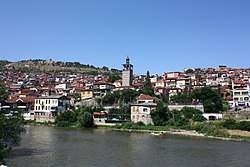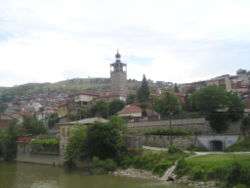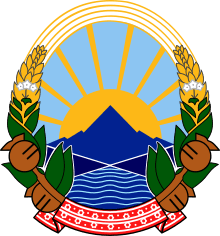Veles, North Macedonia
Veles (Macedonian: Велес [ˈvɛlɛs] (![]()
Veles | |
|---|---|
 Veles | |
 Seal | |
 Veles Location within North Macedonia | |
| Coordinates: 41°43′12″N 21°47′36″E | |
| Country | |
| Region | |
| Municipality | |
| Government | |
| • Mayor | Ace Kocevski[1] (SDSM) |
| Population | |
| • Total | 43,716 |
| Demonym(s) | Veleshanec/Veleshanka |
| Time zone | UTC+1 (CET) |
| • Summer (DST) | UTC+2 (CEST) |
| Postal code | 1400 |
| Area code(s) | +389 043 |
| Vehicle registration | VE |
| Website | www.Veles.gov.mk/ |
Names
Vilazora was initially the Paeonian city Bylazora from the period of early Classical Antiquity. The city's name was Βελισσός Velissos in Ancient Greek.
Under Turkish rule it became a township (kaza) called Köprülü in the Üsküp sanjak (one of the administrative divisions of the Ottoman Empire). From 1877 to 1912 the sandjak was part of the Kosovo vilayet. It played an important part in Ottoman history, as it was where six Grand Viziers hailed, and is still known as Köprülü in Turkish. In Albanian it is known as Qyprill, for the same reason as the Turkish variant.
From 1929 to 1941, Veles was part of the Vardar Banovina of the Kingdom of Yugoslavia. After World War II, the city was known as Titov Veles after Yugoslavian president Josip Broz Tito, but the 'Titov' was removed in 1996.[2] Cars registered in Veles were identified by the code TV (Titov Veles), which was changed as late as 2000 to VE.
History
.jpg)
The area of present-day Veles has been inhabited for over a millennium. In antiquity, it was a Paionian city called Bylazora, and contained a substantial population of Thracians and possibly Illyrians. It was then part of the Byzantine Empire, and at times the First and Second Bulgarian Empire. It became part of the Kingdom of Serbia at the end of the 13th century, while during the Serbian Empire (1345–71) it was an estate of Jovan Oliver and subsequently the Mrnjavčević family until Ottoman annexation after the Battle of Rovine (1395). Before the Balkan Wars, it was a township (kaza) with the name Köprülü, part of the Sanjak of Üsküp.[3]
Ecclesiastical history
Some identify Veles with the Velitza of which Saint Clement of Ohrid was bishop.[4][5]
The Annuario Pontificio identifies Veles instead with the Diocese of Bela, a suffragan of the Metropolitan Latin Archdiocese of Achrida (Ohrid) in Bulgaria, and lists it, as no longer a residential diocese, among the Latin titular bishoprics.[6] It is probably in Bosnia and Hercegovina [7] (modern Velika?).
Modern city

Through North Macedonia Veles is known as industrial center and recently, as a leader in the implementing of IT in the local administration in North Macedonia.
Veles is a place of poetry, culture, history and tradition, as well as a city with plentiful and precious cultural heritage and centuries old churches.
Veles is a municipality of 55,000 residents.[8] The geographic location of the city of Veles makes it suitable for hiking and camping, especially at the west side of the city. One such location is the tranquil village Bogomila. Nearby there is the man made lake Mladost, which is known as the city's recreational centre.
Veles made international news in 2016 when it was revealed that a group of teenagers in the city were controlling over 100 websites producing fake news articles in support of U.S. presidential candidate Donald Trump, which were heavily publicised on the social media site Facebook.[1][9][10][11]
Media
Two TV stations operate in Veles -Channel 21 & Zdravkin- and many radio stations.
Sports
Veles has many sports teams, the most popular of which are :
- FK Borec, football
- FK Gemidžii, football
- RK Borec, handball
- BK Borec, wrestling
- KK Unibasket, basketball
International relations

Notable locals
- History, royalty and politics
- Köprülü Fazıl Ahmed, Ottoman grand vizier
- Gheorghe Ghica, Prince of Moldavia
- Metodi Aleksiev, revolutionary
- Jovan Babunski, Chetnik vojvoda
- Panko Brashnarov, revolutionary
- Ilija Dimovski, member of the Assembly of North Macedonia
- Vasil Glavinov, revolutionary
- Ivan Naumov, revolutionary
- Kole Nedelkovski, revolutionary
- Kazım Özalp, Turkish military office
- Faik Pasha, general of the Ottoman Army
- Jordan Popjordanov, revolutionary
- Mile Pop Yordanov, revolutionary
- Lazar Petrović, Serbian general and adjutant of King Aleksandar Obrenović
- Culture
- Bobby Stojanov Varga, painter
- Kočo Racin, writer
- Rayko Zhinzifov, poet
- Svetozar Ristovski, film director
- Yordan Hadzhikonstantinov-Dzhinot, teacher and publicist
- Zivko Prendzov, art graphic
- Sports
- Ezgjan Alioski, footballer
- Panče Kumbev, footballer
- Safer Sali, Olympic wrestler
- Ljubomir Spasik, wildwater canoeist
References
- Tavernise, Sabrina (7 December 2016), "As Fake News Spreads Lies, More Readers Shrug at the Truth", The New York Times, p. A1, retrieved 9 December 2016
- Велес по осамостојувањето на Македонија Општина Велес
- Rahmi Tekin, Osmanli Atlasi, Istanbul 2003
- Angeliki Delikari, "Clement of Ochrid (Saint)." Religion Past and Present. Brill Online, 2013. Retrieved 23 November 2013
- Clemens van Ohrid
- Annuario Pontificio 2013 (Libreria Editrice Vaticana 2013 ISBN 978-88-209-9070-1), p. 847
- http://www.gcatholic.org/dioceses/former/t0288.htm
- veles.gov.mk Archived April 23, 2009, at the Wayback Machine
- Nicholas Kristof (2016-11-12). "Lies in the Guise of News in the Trump Era". The New York Times (opinion). Retrieved 2016-11-21.
- Dan Tynan (2016-08-24). "How Facebook powers money machines for obscure political 'news' sites". The Guardian. Retrieved 2016-11-21.
- Simon Oxenham (2019-05-29). "'I was a Macedonian fake news writer'". BBC News. Retrieved 2019-05-29.
- "Međunarodna suradnja Grada Pule". Grad Pula (in Croatian and Italian). Archived from the original on 2012-05-05. Retrieved 2013-07-28.
